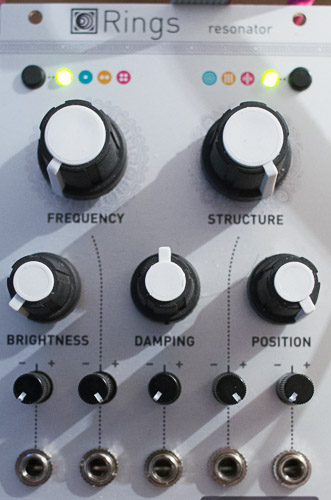Alternate modes
3-voice polyphony
Hold the polyphony button for a few seconds. This enables a 3 voice polyphonic mode in which the notes bounce between the ODD / EVEN outputs according to an 8-step rhythmic pattern (O E E O E E O E).
Alternate resonator models
2-op FM
aka "It's still Bessel functions!"
Hold the model selection button when modal synthesis is active (green).
- STRUCTURE = frequency ratio.
- BRIGHTNESS = FM index.
- DAMPING = FM index and amplitude decay.
- POSITION = Feedback path (no feedback at 12 o'clock).
- IN goes into an envelope follower changing FM index and output amplitude.
This is the same implementation of 2-op FM found in Plaits!
Western chords
Hold the model selection button when sympathetic strings model is active (orange).
The sympathetic strings are no longer tuned to perfect fifths or octaves, but instead, to chords.
STRUCTURE = chord.
Karplusverb
Hold the model selection button when non-linear string model is active (red).
This is similar to the original model, but with a reverb, the absorption and decay of which follow those of the string.
Easter egg
Disastrous peace, an Organ/String machine synth, loosely based on the Roland RS-09
Adjust the knobs to match this picture:

Hold the model selection button for a few seconds. Note that the very same procedure should be used to leave the easter egg.
Polyphony button = chord size. From 10-note fat chords which cannot overlap because they eat all the polyphony voices... to 3-note chords which can overlap with the previous ones when they are retriggered. In other words, that's the maximum number of successive chords which can overlap - 1, 2 or 4.
Model selection button = FX. Long press to get a variation on the FX. Green = formant filter (less abrasive variant). Yellow = Rolandish chorus (Solinaish ensemble). Red = Caveman reverb (shinier variant).
- FREQUENCY = root note.
- STRUCTURE = chord type.
- BRIGHTNESS = scans through various registrations sorted by brightness. Each registration is a different mixture of octaves of square and sawtooth waves.
- DAMPING = decay time, then attack time. Drones continuously when turned fully clockwise.
- POSITION = FX amount.
The STRUM input triggers the envelope and allocates a new group of voices for the chord - and the previously played chord can still be heard if the "polyphony" setting is set to 2 or 4.
The V/OCT input controls the root note. If nothing is patched in the STRUM input, sudden changes on this input will also trigger the envelope / voice allocation.
IN is simply routed to the FX processor.